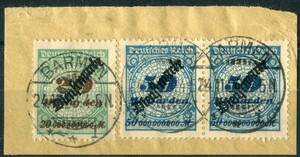EXPANDING A COLLECTION

It's not just about the increasing number of pages, a new binder in matching make or style can accommodate that problem. Easy!
It's more about what happens when the collection of basic stamps is approaching completion. Source of supply and affordability become more important problems for the last few gaps. This is actually an exciting time, because new possibilities emerge.
More budget and time can be spent on deepening knowledge, beginning with a more specialised catalogue. For example, Gibbons "Germany" is 400 pages, but Michel Specialised Parts 1 & 2 amounts to 2688 pages packed with fine-print detail.
Shades and postmarks become meaningful, and a good (and free!) source can be all those duplicates one had stashed over years as "unwanted" in an old stockbook. Well worth exploring them in a new light. Or, buying large accumulations of duplicated older stamps provide a very cheap way of spending time and knowledge to make new finds.
Here is an example of expanding pages :
German 1920s Inflation stamps mostly cost only pence as basic stamps. But, there exist entire sheets which show complex marginal markings; some with overprinted bars at the top of sheets showing local emergency production in different regions. "Han" numbers (the unique print run, a form of dated corner block), booklets and se tenant pairs or multiples from booklets all tell a story.
Acquire a record of the postal rates of the period (see Michel part 1 pages 378/79 for a table of the more basic rates), then make album pages for each of the 31 rate changes between 1916 and 1923 - a basic inland letter cost 15pf in 1916 but 100 Milliarden Marks (100 thousand million Marks = a Billion in English style, 100 billion in American) by the end of inflation. Leave spaces to find a single stamp that would correctly pay the relevant rate (or smallest multiple where the German Post never had time to design and print a stamp for that rate). It would be quite a challenge, making an album providing a thought-provoking display.
Then, delve into postal history and try and find correctly franked covers for all those rates. In the high inflation, covers were often slightly over-franked, because it was hard to find stocks of the correct face value stamps, and anyway, what did a few million extra marks matter when posting a letter?
Well, here's wishing you happy expansion!
- Published
- 22/01/22 06:59:00 AM
